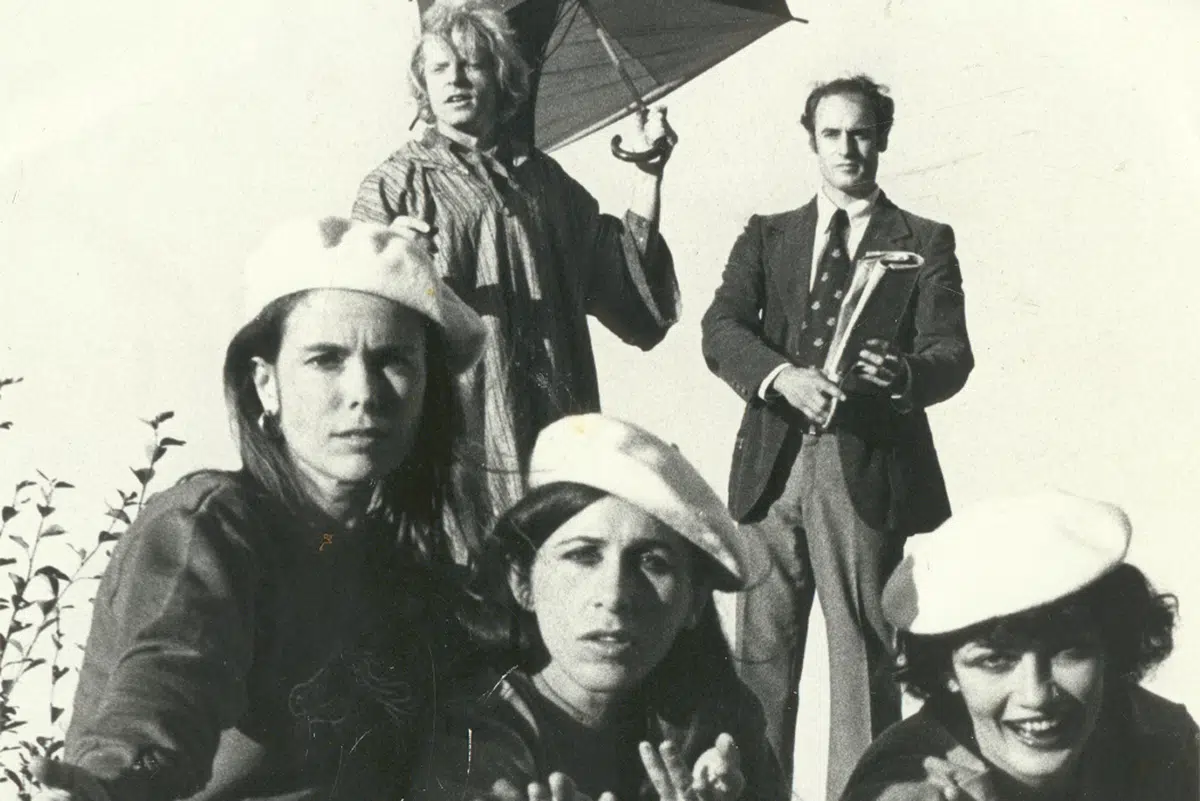There was a lot they hadn’t quite figured out yet, but that didn’t matter. The folks at Synergia Ranch—an intentional community founded in spring of ’69—had already, with sheer will, turned an arid plot of desert, about 30 minutes outside Santa Fe, into a four-acre fruit orchard with dozens of adobe structures, built one brick at a time with clay found on the land. Informed by thinkers such as futurist Buckminster Fuller and Whole Earth Catalog founder Stewart Brand, their vision was simple: to make the world a better place. And in order to do that, they needed a vehicle with which they could traverse the entire world—literally. So in the summer of ’74, they packed up their lives into a blue school bus they had refurbished themselves and drove from Santa Fe to Oakland, with a vision of building a ship that had begun, quite simply, as a sketch on the back of a napkin one evening at the ranch. They would name the ship “Research Vessel Heraclitus,” in honor of the Ancient Greek philosopher, who famously wrote: “No man ever steps in the same river twice, for it is not the same river and he is not the same man.” The name would turn out to be more apropos than they ever could have anticipated.
The Heraclitus would go on to spend the next 40 years sailing on expeditions that would take them to every continent—and along the way, they’d pick up many other scientists, artists, and dreamers, including now-iconic ethnobotanists Terence and Dennis McKenna and Wade Davis, who did seminal, early investigations into dozens of psychoactive plants and fungi used by Indigenous Amazonian groups.
“I think the insight was really simple. If we want to learn about the world, how could we ignore the ocean, which is 70 percent of the land surface?” says Mark Nelson, chairman and chief executive officer of the Institute for Ecotechnics, a nonprofit established by folks at the Ranch and the group at the helm of the Heraclitus.
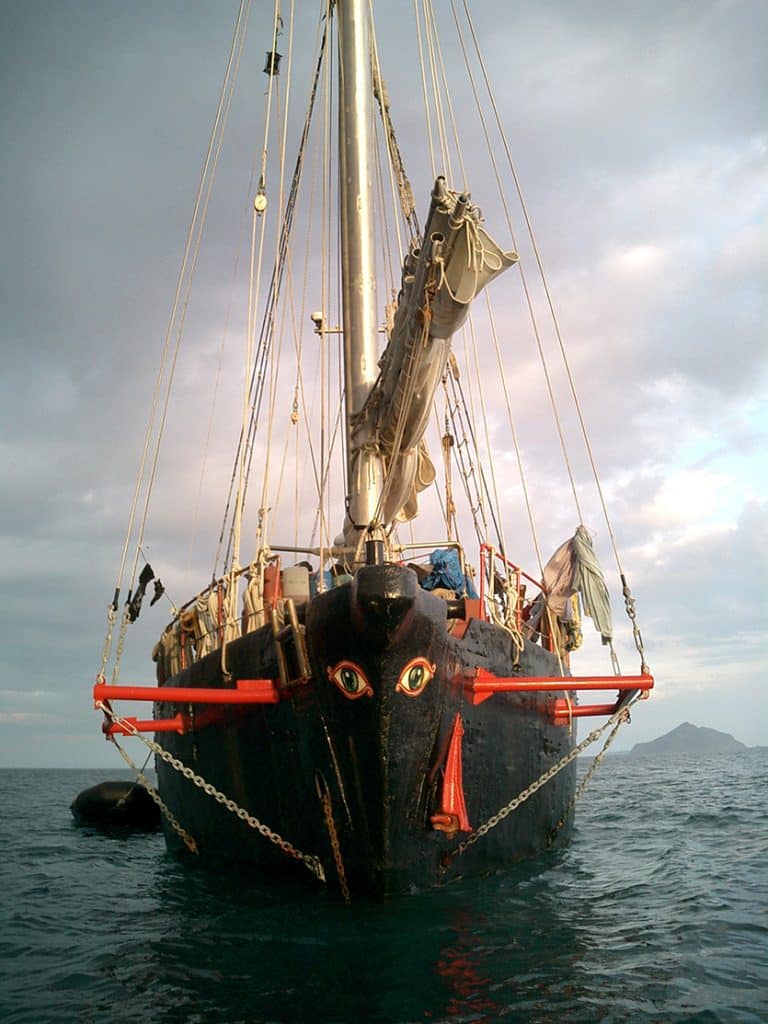
Established in 1973, the Institute was rooted in the same idealism and grit that ultimately birthed dozens of ambitious projects (in addition to the Heraclitus), many of which are ongoing—from a land restoration project on more than 4800 acres in remote Western Australia to a rainforest enrichment project in Puerto Rico. Perhaps, most notably, between 1987 and 1991, the group created Biosphere 2, a fully enclosed ecological system in Arizona modeled after the Earth’s biosphere to see if it was possible for humans to create something like it on Mars and survive. Eight people lived inside it for two years, including Nelson.
Everyone credits the founder of Synergia and inventor of Biosphere 2—John Polk Allen, now 93 and still living at the ranch—as the leading visionary behind it all. Allen, the epitome of a renaissance man, with degrees in engineering, history, writing, anthropology, and business from Harvard, always had big dreams, from the time that he was a young boy, growing up in Oklahoma during the Dust Bowl. And he always dreamt with flair, too, with his bolo ties and fedora caps; He remains beloved and revered among folks at the ranch.
The institute’s mission was—and still is—to engage in projects through the lens of “ecotechnics,” which espouses that the ethnosphere (defined as the “‘cultural web’” of unique attributes and customs around the world, from language to music to food to handicrafts”), the biosphere (the parts of earth where life exist), and the technosphere (the parts of the environment which are made or modified by humans) are connected and can all work synergistically together. Essentially, the idea is that humans, animals, the ocean, the cultures and traditions created by humans, technology—anything and everything that exists is connected. Ecotechnics proposes that humanity must understand this—rather than create false divisions—in order to properly resolve the ecological challenges our planet and species face.
Read: Can Psychedelics Rekindle Ancient Animism in Modern Society?
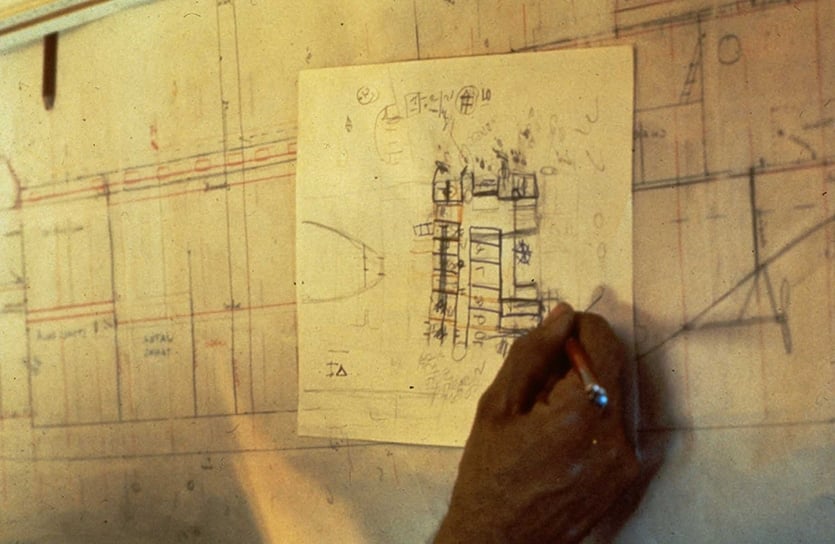
From the get-go, Allen envisioned theater as the foundation upon which he and his colleagues would build future projects, whether that was dragging a net off the back of the Heraclitus to gather plankton, working with a community of Tibetan refugees to create a travelers’ hotel in Kathmandu (it still exists; Google “Hotel Vajra”), or an exhibition space (which also still exists) called the October Gallery in London, devoted to avant-garde works from cultures around the world. Throughout it all, theater performances and exercises—improvisation; emotional catharsis through howling, laughing, and other spontaneous noises; and getting out of the mind and into the body through movement—were core to their cooperation and the sentiment that they really could do anything. Fittingly, the theater troupe called themselves The Theater of All Possibilities.
How to Grow Shrooms Bundle
Take Both of Our Courses and Save $90!
The building of the Heraclitus was like one giant theatrical improvisation. When they first had the idea for the ship, they knew very little about sailing, let alone constructing the vessel itself. They divided up the learning among members of the team, from engineering and design to celestial navigation. (Bear in mind, on a junk or Chinese sailing ship with fully battened sails, like the one they were building, everything is entirely weather-dependent and the crew must have a sophisticated understanding of wind patterns to successfully get anywhere.) The ship was largely built with found materials in the surrounding environment as well as donations and volunteers that they attracted with their nearby project cafe, The Junkman’s Palace.
A pixelated video from ‘75, when the Heraclitus first hit the waters, puts the feat into perspective. After months of working 24 hours a day, the ship was done—and, in theory, would float. But they didn’t know if it actually would. The crew had booked a tow boat to pull the ship from the dock at Fifth Avenue Marina into the Oakland Harbor. In the video, the tow boat can be seen pulling the ship from the docks via ropes tied to the front of it. It’s slowly, slowly sliding down the dock, at what appears to be a 45-degree angle with its nose ready to plow headfirst into the harbor, when suddenly the back of the ship slides in, too, the vessel evens out, and it floats. The half-dozen people or so on the deck of the ship start hugging and jumping up and down, ecstatically, as though in disbelief. They took a victory lap under the Golden Gate Bridge, the iconic red overpass juxtaposed against the bright blue sky. They encountered 20-to-25-foot waves, the radar fell off, and everything on deck started toppling, because it wasn’t tied down, but it didn’t matter. The ship sailed—and would continue to for decades.
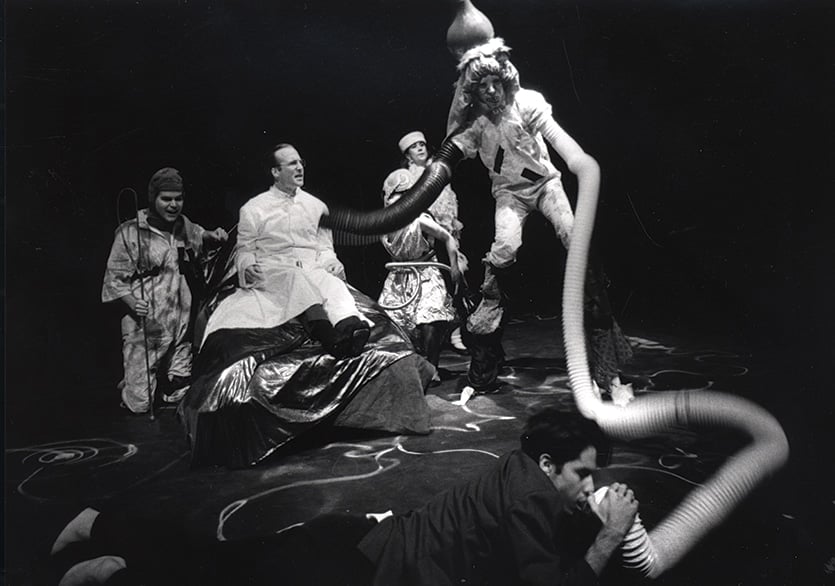
Their maiden voyage lasted from ‘75 to ‘79, taking them from the San Francisco Bay down the coast to Panama, through the Panama Canal, and then stopping at the San Blas Islands, Martinique, the British Virgin Islands, and Great Inagua. They, then, crossed the Atlantic for the first time, taking off from Miami, stopping in Bermuda, Morocco, and Spain, and docking in Marseille, where crew members attended an Institute of Ecotechnics Ocean Conference, which assembled experts from around the world to discuss the vast seas they had been traversing. The first voyages as well as the construction of the ship were funded by members of the institute, as well as made possible by many in-kind donations from supporters they met in Oakland.
They then set sail to Corsica, through the Suez Canal to the Red Sea, and across the Indian Ocean to Mumbai. In collaboration with the University of Bombay, the Heraclitus crew studied the expansion of the Middle Eastern reed boat culture to the Andaman Islands off India, and assisted with research of mercury contamination in the rivers of Maharashtra. They then went east to Sumatra, Singapore, and finished in Australia. On their second voyage, they circumnavigated the Indian Ocean, where the crew performed coral reef studies with the University of Singapore.
Everywhere they went—from Southeast Asia to the Mediterranean to Antarctica—they were driven by their core principles of cultivating a deeper understanding of the planet, and supporting regenerative projects, whether artistic, cultural, or scientific. And everywhere they went, too, their theater went with them, exchanging performances with Balinese dance masters in Denpasar and Indigenous Australian and Amazonian groups as a means of communication and cultural exchange that transcended language.
Read: What Permaculture Teaches Us About Psychedelics

Dennis McKenna and Wade Davis both still vividly remember their first encounter with the Heraclitus crew in the early Eighties. McKenna says he had first heard of the Heraclitus through his graduate school supervisor, Neil Towers, at the University of British Columbia. Towers had received word from Dr. Franklin Ayala, the director of the herbarium in Iquitos, a part of La Universidad de Lima, that a group called the Institute of Ecotechnics, which had a relationship with Richard Evan Schultes, a pioneer in the field of modern ethnobotany, was going to be in the Amazon at the same time as one of his graduate students (Davis) and suggested they team up.
“Well, we thought that was great,” recalls McKenna. “We would love to get some transport and get our gear down there. And they had sent us a picture of the Heraclitus and so on, and we thought this will be cushy, this will be even luxurious, almost. So we were expecting them to come and we would sign on and we would go down there and make these collections…Well, it didn’t quite work out that way.”
The crew had entered the Amazon in Belém, Brazil, took off the sails (only needed for ocean sailing), and began motoring down the river. But the Heraclitus was struggling. The Amazon—full of dissolved particles that give it its distinct silty appearance—wore away at the cutlass bearing, where the propeller shaft goes out of the ship to turn the propeller. So Dennis, Terence, and Wade were waiting for the ship in Iquitos to head further downstream, but when it arrived, it was out of commission. And when they showed up on the ship to meet everyone there was “kind of a strange vibe,” recalls McKenna. They were sitting around, drinking tea, waiting for dinner when the crew, without warning, began howling.

“They just continued this howling for the next 20 minutes or so and no explanation,” he says. “It was like it was the most natural thing in the world to howl before your meal. That was a clue that these people were even weirder than we were, which was really saying something.” During the meal, there was “stony silence.” Afterwards, everybody went around and spoke, one at a time. “The rules, which we sort of, again had to intuit, were that anyone could say anything they wanted, but nobody could respond to it,” recalls McKenna. “You couldn’t criticize it, you couldn’t say, ‘that’s a great story or tell us more.’ You’re supposed to put it out there and then move on to the next person.” The McKennas and Davis were struck, too, by the fact that the Heraclitus crew members all had nicknames or “sobriquets,” as the scientific chief at the time Robert “Rio” Hahn (known as Rio, or river in Spanish) calls them.
It was only later, after the Heraclitus sent the McKennas and Davis down the river in a smaller boat, with two members of their crew who went by “Nada” (“nothing” in Spanish) and “Moondance” that they started to put the pieces together: The ship, the citizen science, the theatrics—it was all art, it was all connected, and it was all with the vision towards a better world.
“I think that the story of the Institute of Ecotechnics is a story of really courageous and well-intentioned people coming together to try to envision a new dream of the Earth,” says Davis. “And once I kind of realized that’s what it was all about, I became very fond of them all.”
Read: The Function of Awe
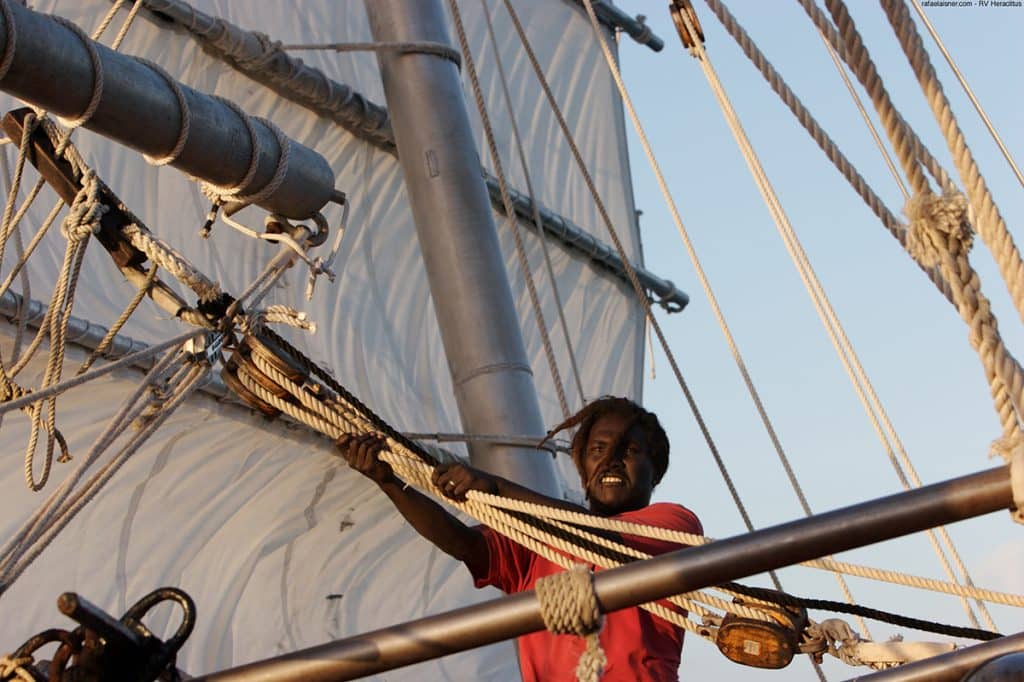
Eventually, the Heraclitus made it to the jungle and moored along the bank at Pebas, just off the main Amazon waterway on a tributary known as Rio Ampiyacu. During the day, the crew collected more than 1200 botanical samples with the support of shaman from the Witoto and Bora tribes, and, at night, they danced, exchanged performances, and ate ceviche and platanos, joined by the officers at the army base stationed nearby. They gave sets of their samples to the Iquitos Herbarium, the Missouri Botanical Garden, the New York Botanical Garden, and the Royal Botanic Gardens, Kew in England—a major contribution, says Hahn, since samples were not typically allowed to be taken out of the jungle, but the Institute had established a partnership with La Universidad de Lima which allowed them to.
From the Amazon, the Heraclitus embarked on nine more expeditions, until 2012 when it became clear it had sailed as far as it would without an infrastructural overhaul. It’s docked now in Roses, Spain, where volunteers have been rebuilding it since in the hopes that it will, once again, sail the open seas. They’re asking for in-kind donations as well as fiscal sponsors, and need about $1 million dollars to get the ship sailing again in the next two to three years.
That original trip to the Amazon—the Heraclitus’ first major expedition—was inspired by a speech given by Richard Evan Schultes at the Institute for Ecotechnics “Jungle Conference” in Kuala Lumpur in 1979. At the time, Schultes, known for his research into hallucinogenic plants in Mexico and the Amazon, as well as for his book co-written with the world’s first LSD chemist Albert Hofmann “The Plants of the Gods: Their Sacred, Healing, and Hallucinogenic Powers,” pled with the people at the conference:
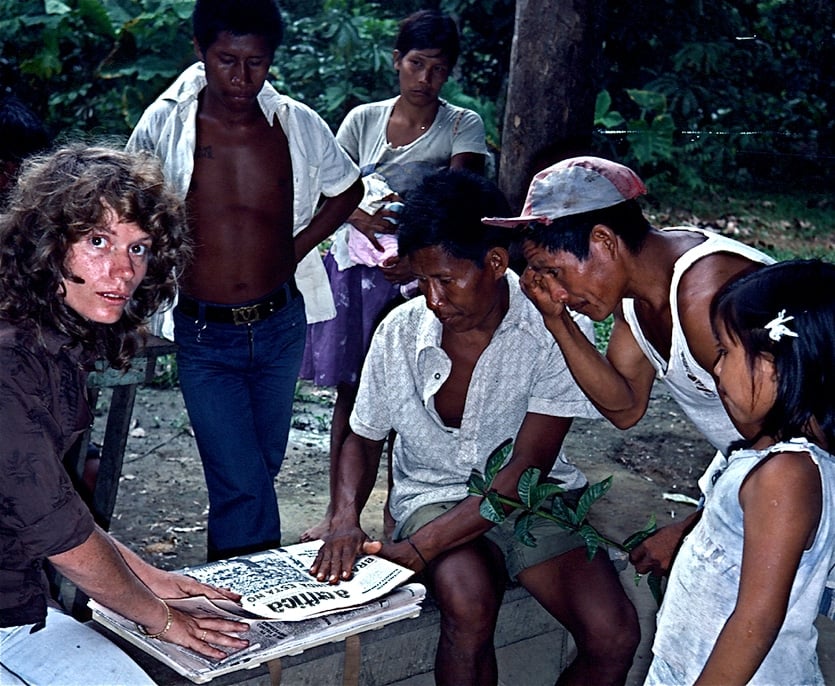
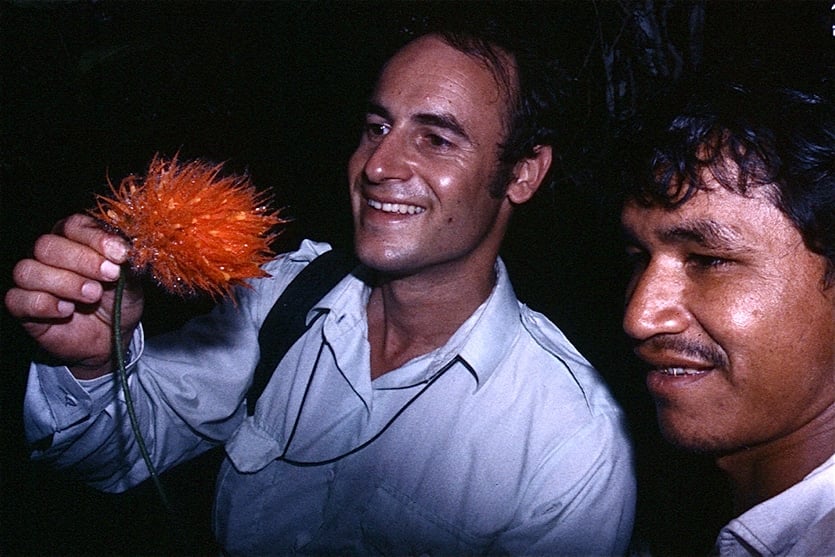
“No matter where we look, the Amazon valley, the Congo, New Guinea, elsewhere, the rich equatorial forests provide man with all of his needs,” Schultes said. “We have very little time left and I urge the environmentalists and organizations like Ecotechnics to join hands even more closely than they have been doing with the naturalists.” The Heraclitus, parked outside, was the obvious contender for an expedition, and Schultes urged the institute to take it down to the Amazon, to resume the work he’d been doing there.
Forty-three years later, the founding members of the ranch say there’s more work to be done than ever—and they’re not slowing down. With initiatives from a water remediation project in Iraq to a press, called Synergetic, which publishes texts on psychedelics, the biosphere, and beyond, they’re still traversing the globe while recruiting the next generation of dreamers. The Heraclitus is an integral part of that.
How to Grow Shrooms Bundle
Take Both of Our Courses and Save $90!
“We’ve engaged so many people, a lot of young people, in the rebuild,” says Handte. “I know that they will join us on the voyage and that eventually there will be a new generation taking the ship over, taking the heritage on and creating their own dreams.”
This article was originally published in DoubleBlind Issue 7. To help The Heraclitus set sail again or just to connect, visit www.rvheraclitus.org or contact [email protected].

DoubleBlind is a trusted resource for news, evidence-based education, and reporting on psychedelics. We work with leading medical professionals, scientific researchers, journalists, mycologists, indigenous stewards, and cultural pioneers. Read about our editorial policy and fact-checking process here.

DoubleBlind Magazine does not encourage or condone any illegal activities, including but not limited to the use of illegal substances. We do not provide mental health, clinical, or medical services. We are not a substitute for medical, psychological, or psychiatric diagnosis, treatment, or advice. If you are in a crisis or if you or any other person may be in danger or experiencing a mental health emergency, immediately call 911 or your local emergency resources. If you are considering suicide, please call 988 to connect with the National Suicide Prevention Lifeline.
